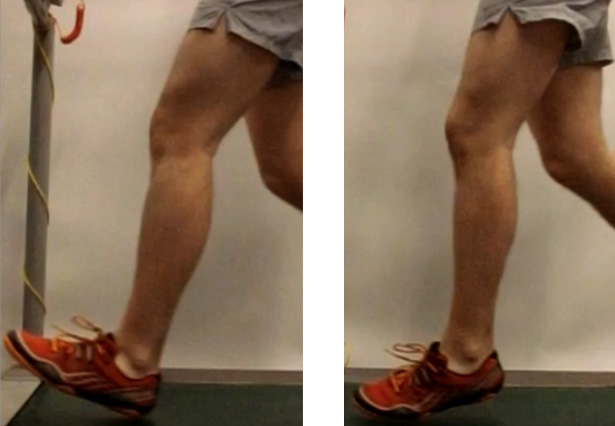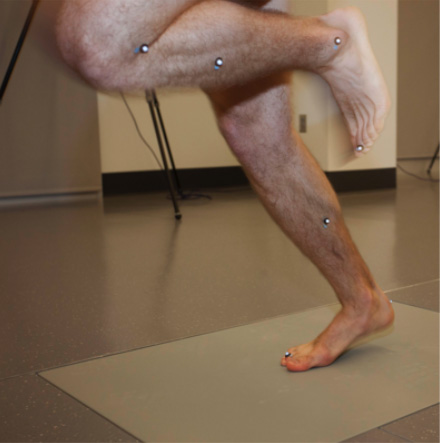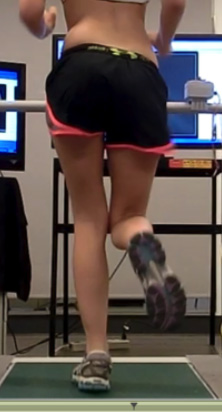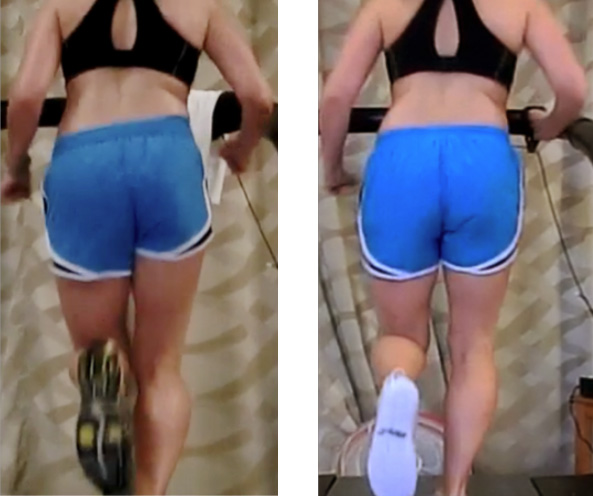According to evolutionary biologists, humans have been running for about two million years. For most of this time, running was essential to human survival—activities like hunting, warfare, and fleeing danger produced better outcomes at a faster pace. It is only in the last few hundred years that running has become a recreational skill confined to the realms of sport or diet, a trend that has increased in the western world as our daily lifestyles become more sedentary.
One key is what you wear—or don’t wear—on your feet.
Despite this long history of human running, somewhere between one and three quarters of all runners will be injured in a given year. For
physical therapist
and
biomechanics
expert Dr. Irene Davis, the huge number of running injuries was something of a puzzle. “Running is something the human body has evolved to do over 2 million years,” explains Dr. Davis, “so it didn’t make sense to me why so many recreational runners were sidelined each year.” Over her decades–long career researching running and running injuries, Dr. Davis has come to some surprising conclusions. One key, she says, is what you wear–or don’t wear–on your feet.
Mechanics Explained
Every human body is unique, and each person physically moves through the world in different ways–using different mechanics. Nevertheless, it is possible to categorize certain aspects of human movements, and, in particular, the motions associated with running. For example, runners can be grouped based on what part of their foot hits the ground while running. About 90% of runners are rearfoot strikers, meaning that they hit the ground with their heels. The other 10% of runners exhibit a midfoot or forefoot strike pattern, meaning that they land flat or that the balls of their feet are the first to hit the ground (Figure 1).

Figure 1. Classifications of footstrike patterns. (left) rearfoot strike (RFS) pattern where heel strikes first; (middle) midfoot strike (MFS) pattern where the heel and ball of the foot strike together; (right): forefoot strike pattern (FFS) where the ball of the foot strikes first. (Courtesy of Irene Davis)
Strike pattern influences the relative alignment of the leg at contact. In a rearfoot strike pattern, the leg is often extended out in front of the body with the foot ahead of the knee (Figure 2). In contrast, in a forefoot strike pattern, the foot typically lands beneath the knee resulting in a fairly vertical lower leg.

Figure 2. Leg orientation between different footstrike patterns. (left) A rearfoot strike pattern associated with an extended leg; (right) a forefoot strike pattern associated with a more vertical tibia (Courtesy of Irene Davis)
Because of the complexity of human mechanics, researchers must identify specific variables to quantify and evaluate when studying runners. One straight-forward variable is the amount of force with which the foot hits the ground. This can be measured in the laboratory using a force plate, something like a high-tech bathroom scale. When you stand on a bathroom scale, the scale tells you your weight, which physics defines as your mass multiplied by the acceleration due to gravity. If you were to jump onto the bathroom scale, though, you would notice that your weight momentarily spikes. This is because your acceleration has increased. A typical bathroom scale is designed to only measure your standing weight with no change in acceleration. A force plate, however, detects the changes in acceleration and the direction of that acceleration (Figure 3). A treadmill equipped with a force plate collects large amounts of data that researchers use to determine the amount and direction of forces involved in running.

Figure 3. Individual striking a force platform while he is running (Courtesy of Irene Davis)
Another variable researchers measure is the angle of rotation at a certain joint. For example, each person has a maximum degree of internal rotation (towards the opposite leg) and external rotation (away from the opposite leg) in the hips and knees. Using physical markers and tracking devices on the runners’ body while capturing the runner on video, it is possible to quantify the average angle of rotation around a certain joint during a particular stage of the running stride.
Running Injuries
In her work with patients, Dr. Davis became convinced it was possible to reduce running injuries by changing running mechanics. She hypothesized that individual running mechanics influence whether people are injured and, if so, what kind of injuries develop over time. Knees are the most common joint injured while running, and a condition known as
patellofemoral pain
(PFP) is the most common knee injury. It is often associated with running with a knock-kneed gait and pelvic drop (Figure 4). Studies have shown that PFP increases the risk of developing patellofemoral
osteoarthritis
later in life. It also increases the risk of further injury to the knee and other joints.

Figure 4. Runner with knee pain associated with a knock-kneed gait pattern along with pelvic drop (Courtesy of Irene Davis)
Despite treatment, many runners with PFP sustain similar knee injuries in the future.
The “patellofemoral” part of PFP refers to the two bones that join at the knee: the patella, also known as the kneecap, and the femur, the large bone that connects the upper knee to the hip. PFP refers to a number of conditions that cause pain in the front of the knee when the knee is extended and is usually associated with mal-alignment of knee muscles. Traditionally, PFP has been treated by identifying weak muscle groups, and strengthening the leg muscles including the calves, quadriceps, and smaller muscles in the knee. Despite treatment, many runners with PFP sustain similar knee injuries in the future. And despite the frequency of PFP in the general population, the condition has not been well studied.
In her research and practice, Dr. Irene Davis has worked with many patients with PFP. Dr. Davis is the Director of the Spaulding National Running Center at Harvard University and Professor of Physical Medicine and Rehabilitation at Harvard Medical School. Her research and case reports demonstrate that PFP symptoms can be improved significantly by altering a patient’s running mechanics.
In one study, Dr. Davis and colleagues (Willy et al. 2012) conducted an experimental treatment in ten female runners with PFP who exhibited abnormal hip alignment. All participants had already undergone physical therapy treatment focused on muscle strengthening but reported little improvement in their symptoms. Dr. Davis and her colleagues wanted to know if the PFP symptoms could be improved by altering the runners’ hip mechanics.
To do this, the researchers worked with the participants in eight
gait
re-training sessions over two weeks. Participants were asked to run on a treadmill placed in front of a full-length mirror and were given verbal cues to improve their alignment. All sessions were videotaped, and body markers were used in the first and last sessions to evaluate changes in hip rotation. Follow-up analyses were conducted one and three months following the re-training sessions.
The results of this study were quite promising. All ten participants reported a decrease in knee pain that was associated with an improvement in their hip and knee alignment (Figure 5) following the two weeks of re-training. This decrease lasted the entire length of the three-month follow-up study. In addition, the improved alignment in running also carried over to other skills such as squatting.

Figure 5. Effect of gait retraining on hip and knee alignment. (left) At baseline, note the pelvic drop and knock-kneed gait. (right) Following the retraining, note the improvement in hip and knee alignment (Courtesy of Irene Davis)
Abnormal hip rotation is one aspect of running mechanics that has been associated with the development of PFP. Another is a runner’s strike pattern: whether the heel or the ball of the foot hits the ground first.
Rearfoot to forefoot
Drs. Davis and Cheung (2011) showed that pain associated with knee injuries can be reduced by switching from a rearfoot to a forefoot strike pattern. This study focused specifically on runners with PFP. The researchers conducted a study in which they followed three female runners with PFP who exhibited a rearfoot strike pattern. The three participants underwent eight gait re-training sessions over the course of two weeks. A buzzer was attached to the heels of the runners’ feet, and every time the heel hit the ground it would make a sound. The runners were instructed to eliminate the buzzer sound by landing on the fore-foot or mid-foot rather than the heel. At the end of two weeks, the runners had reduced their heel strikes by 90%. As a result, participants reported a reduction in pain associated with PFP between 10% and 35%.
Both of the studies described above were with a small number of patients. However, these studies demonstrate new approaches to treat PFP, and by extension other running injuries. These data provide the basis for larger follow-up studies. “As a physical therapist, I have seen these types of positive results time and again,” explains Dr. Davis. “Now we have data that support our clinical findings.”
Avoiding Injury
As a physical therapist, Dr. Davis treats patients who have already been injured. Most academic studies focus on injuries and ways to improve treatment and treatment outcomes. A different avenue for research is to examine runners who remain free of injury and compare their mechanics to runners who sustain injuries. This was the purpose of the 2015 study Dr. Davis and colleagues conducted, surveying 249 female runners with a rearfoot strike pattern over two years. During the course of the study, more than half of the participants lost running time due to injury, with about 100 participants needing to seek medical attention. The others were not injured during this two year period but most had been injured at some point in their running careers. There were 21 runners, however, who had never been injured. Dr. Davis and her colleagues focused on these never-injured participants to try to understand how to remain injury free.
Injuries may be avoided by running more lightly, as if you were running on eggshells or over water.
Looking at the data gathered over the two-year study, the researchers determined that the runners who remained injury free had very minimal impact on hitting the ground when compared to runners who had been injured. “This is our key finding,” Dr. Davis comments, “and it is one that is supported by all our previous research. The less force the body absorbs with each landing, the less likely it is for an injury to develop.”
How can runners reduce the impact on their joints while running? One simple way is to imagine running more lightly, as if you were running on eggshells or over water. Runners can also increase the number of strides taken per minute, which often reduces the impact on the joints in any given stride. Dr. Davis believes one of the biggest changes we can make is to get out of our shoes.
Humans have been running for 2 million years, but it’s only in the past 50 years that high injury rates have been observed–somewhere between 25% and 75% of runners will get injured in a given year. “It is like birds injuring their wings or fish injuring their fins doing something they were adapted to do,” explains Dr. Davis. For her, the fact that runners are being injured so frequently means that something about their running may be wrong.
Running Free
According to Dr. Davis, one way to avoid injury is to get out of high-tech sneakers that provide too much stability and support. If you were to go running barefoot, what part of your foot would you land on? Imagine trying to run landing on your heels all the time. It would hurt! And it is certainly not the most efficient way to run. Instead, it is much more comfortable to land on the ball of your foot because it is better able to absorb the force and propel you forward. So why do so many people land on their heels?
Dr. Davis believes that modern footwear is the culprit. “Sneakers that stabilize and cushion our feet have fundamentally altered our running mechanics,” explains Dr. Davis. Remember that it hurts to land on your heels when running barefoot. With so much cushioning around the heel in our state-of-the-art sneakers, however, it becomes much easier and more comfortable to land on our heels. But that doesn’t mean that the rest of the body—ankles, knees, and hips on up—can properly absorb the extra impact of repetitive heel-strikes.
Fortuitously, Dr. Davis’s research has coincided with a re-emergence of “minimal sneakers.” Minimal sneakers protect the soles of the feet from the running surfaces but do not offer much support. Rather, the foot and calf muscles stabilize the rest of the body the way they were designed to. “I never set out to become an advocate for minimal sneakers or for running barefoot,” recalls Dr. Davis, “but this is what the evidence shows may be the best way to prevent injury.”
Looking back, Dr. Davis wonders why it took her so long to reach this conclusion. As a physical therapist, she always offered her patients the least supportive option available: less supportive braces for spinal cord patients or less supportive wheelchairs for patients who cannot walk. The idea was to make the patients use as many of their own muscles as possible. To understand how this works, imagine taking a healthy person and putting a neck brace on them for an extended period of time. What would happen when the neck brace is removed? Where once the neck muscles were strong and able to support the head, after too much time in a neck brace they are no longer able to do so. This is what Dr. Davis believes has happened with our feet, which have spent a long time in overly supportive shoes.
Dr. Davis herself runs barefoot, but she cautions that it must be a slow transition from supportive shoes to minimal ones. The stability provided by our supportive shoes actually weakens the muscles that would normally do that job. If you jump right into running with non-supportive shoes or running barefoot, your body may not be ready and this, too, can result in injury. Before running with minimal shoes or barefoot you have to build up appropriate strength in the feet and calf muscles.
A study conducted by Drs. Willy and Davis (2014) examined 14 male runners with a rearfoot strike pattern as they tried running in minimal shoes for the first time. The researchers found that use of minimal shoes did not automatically alter strike patterns or other running biomechanics in a significant way, and that the force of each strike actually increased. Looking back, Dr. Davis suggests that this might be due to the fact that the shoes, while considered minimal at the time, had significant cushioning. Other studies have shown that running in minimal shoes with cushioning results in similar mechanics to running in traditional shoes. The increase in impact force was surprising, but this may be attributed to the fact that runners were not accustomed to running in these shoes. As a result, Dr. Davis has focused her minimal footwear studies on runners wearing the shoes they usually wear.
Before running with minimal shoes or barefoot you have to build up appropriate strength in the feet and calf muscles.
In another study, Drs. Davis and Altman (2016) compared the injury rates in barefoot versus non-barefoot (
shod
) runners. The researchers followed 107 barefoot runners and 94 shod runners over the course of a year, gathering data through monthly running logs about injury rates and types of injury. Interestingly, the researchers found similar injury rates between the two groups, but the types of injuries were distinct. Shod runners reported a much greater rate of injury to the knees and hips, whereas most barefoot runners sustained injuries to the feet and lower calves.
From these preliminary findings, Dr. Davis emphasizes the importance of properly strengthening the foot and calf muscles prior to beginning a barefoot running regimen. In addition, Dr. Davis recommends using some kind of footwear to protect the feet when running over uneven or potentially sharp surfaces. This is because the researchers found that barefoot runners sustained a larger number of injuries to the bottom surface of the foot while running barefoot. Finally, Dr. Davis suggests that barefoot or minimal footwear running could be a safe alternative for runners who sustained knee or hip injuries in the past, as a way to protect these joints from future injury, provided that they transition slowly and properly to barefoot running. These researchers are planning additional studies to explore this in the near future.
Dr. Davis’s clinical work and research findings support her case for less supportive footwear. However, not everyone agrees. There are many clinicians and researchers who believe that Dr. Davis’s findings are too preliminary. Dr. Davis welcomes further debate and continued research into running injuries and running mechanics. As Dr. Davis concludes, “This is what science is all about.”
Dr. Davis welcomes further debate and continued research into running injuries and running mechanics.
Dr. Irene Davis is the Director of the Spaulding National Running Center at Harvard University and Professor of Physical Medicine and Rehabilitation at Harvard Medical School. She is Professor Emeritus of Physical Therapy at the University of Delaware where she spent over two decades researching injuries related to running mechanics. Her current research focuses on common running injuries such as patellofemoral pain and bone stress injuries, as well as novel physical therapy interventions such as gait retraining. When not in the laboratory, Dr. Davis enjoys any outdoors activity including hiking and sea kayaking. She is also an avid barefoot runner.
For More Information:
- Altman, A. and I. Davis. 2016 “Prospective comparison of running injuries between shod and barefoot runners.” British Journal of Sports Medicine, 50: 476-80.
- Davis, I.S. et al. 2015. “Greater vertical impact loading in female runners with medically diagnosed injuries: a prospective investigation.” British Journal of Sports Medicine Dec 7. pii: bjsports–2015–094579. doi: 10.1136/bjsports-2015-094579. [Epub ahead of print]
- Willy, R.W. and I. Davis. 2014. “Kinematic and kinetic comparison of running in standard and minimalist shoes.” Medicine and Science in Sports and Exercise. 46:318–23.
- Willy, R., J. Scholz, and I. Davis. 2012. “Mirror gait retraining for the treatment of patellofemoral pain in female runners.” Clinical Biomechanics. 27:1045–1051.
- Cheung, R. and I. Davis. 2011. “Landing Pattern Modification to Improve Patellofemoral Pain in Runners: A Case Series.” Journal of Orthopaedic & Sports Physical Therapy, 41: 914–919.
To Learn More:
- Reynold, Gretchen. “Why we get running injuries (and how to prevent them).” New York Times, 10 February 2016.
http://well.blogs.nytimes.com/2016/02/10/why-we-get-running-injuries-and-how-to-prevent-them/?_r=1
- Davis, I. 2014. “The re–emergence of the minimal running shoe.” Journal of Orthopaedic & Sports Physical Therapy, 44(10): 775-784.
- McKeon, P.O. et al. 2015. “The foot core system: a new paradigm for understanding intrinsic foot muscle function.” British Journal of Sports Medicine 49:290-299.
- Dr. Davis’ website: http://www.runsnrc.org/RUNSNRC/Home.html
- Spaulding National Running Center: http://www.runsnrc.org/RUNSNRC/Director.html
- American College of Sports Medicine: http://www.acsm.org/
- Spaulding National Running Center: http://www.runsnrc.org/RUNSNRC/Director.html
- Link to Interview with Dr. Davis on barefoot running: http://www.runsnrc.org/RUNSNRC/News.html
Written by Rebecca Kranz with Andrea Gwosdow, PhD at www.gwosdow.com

